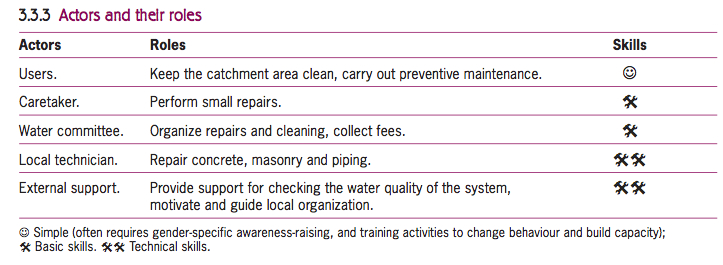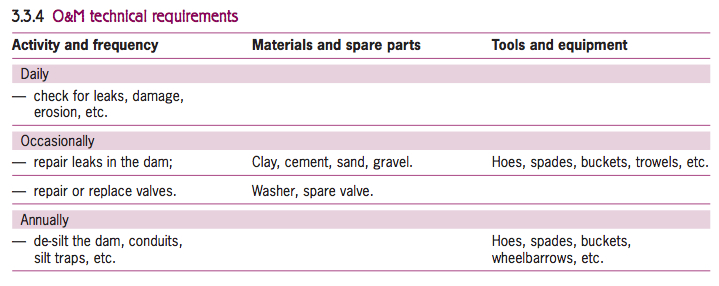Catchment & storage dams
Contents
Catchment and storage dams
Water can be made available by damming a natural rainwater catchment area, such as a valley, and storing the water in the reservoir formed by the dam, or diverting it to another reservoir. Important parameters in the planning of dams are: the annual rainfall and evaporation pattern; the present use and runoff coefficient of the catchment area (e.g. bare rock catchments have high runoff coefficients, around 0.9); water demand; and the geology and geography of the catchment area and building site.
Dams can consist of raised banks of compacted earth (usually with an impermeable clay core, stone aprons and a spillway to discharge excess runoff), open rock reservoir catchments, and masonry or concrete (reinforced or not).
Open reservoirs behind a retaining structure have storage capacities ranging from 20 – 4,000 m³. Alternatively, a volume of water could be stored directly into covered storage tanks that collect water directly from the catchment.
The water stored behind a dam should normally be treated before entering a distribution system.
Suitable Conditions
Site reservoirs where the base will be impermeable (e.g. unfissured rock or clay) in order to save costs and prevent having to find a form of lining. Alternatively cracks and fissures could be sealed up with mortar or concrete. Rock catchment dams work well mostly in hilly or mountainous regions where other water sources are scarce. These types of dams should be bare and free of vegetation/soil. When siting for rock catchment dams make sure to maximize the natural topography – to get the best volume, make dams on the lower side of existing rock pools.
Optimally, dams less than a few metres high or as low as one metre work best for small communities. The width, however, can be from a few metres to hundreds of metres. If larger dams are desired, specialized engineering help should be sought.
Smaller scale dams owned privately might have more chance of success in terms of participation in the construction and maintenance processes.
| Advantages | Disadvantages/limitations |
|---|---|
| - High runoff coefficient is good, enabling water to collect very well from small rains - Minimal seepage where open storage on rock catchments is concerned |
- Contamination of the water from surrounding land use and animals - Water-borne disease susceptibility |
Construction, operations & maintenance
Building the dam
Reservoir size and dam height can be decided according to water demand, evaporation losses, length of critical period and average rainfall. For a full list of methods to determine your dam’s size, visit CARE: Nederlands Desk study Resilient WASH systems in drought prone areas (page 62).
A dam wall can be built onto rocks with a slope of up to 15%, width of dam base must always be 3/5 of dam height, width of crest should be 30cm, special attention should be paid to the rock-wall base as this has potential for leakage, and the upstream side of the dam wall should be rendered with up to 30mm of mortar. Material used for the dam wall should be impermeable with high clay content (55% minimum). Avoid unwanted components in the clay. Procedures for dam wall construction are given in certain guides.
When constructing valley dams specifically (those in a seasonal watercourse), the rule of thumb is not to build small reservoirs (below 10,000 m3) in catchments larger than 400 ha (1,000 acres).
Gutters are needed to direct water on the catchment towards the reservoir. They can be made from stone masonry using rocks gathered from the catchment during cleaning. Gutters should almost follow the contour but should slope a minimum of 3%. Gutters should be high enough to direct water, but where runoff velocity is very high, some kind of wall structure is needed to slow velocity of runoff before it reaches the gutters.
Water Quality & Treatment
If the water is for human consumption, cattle and people should be kept away from the catchment area and reservoir all year round. This can be helped by having a watchman patrol regularly, and by fencing off the area. Fish can be introduced to eat mosquito larvae, while at the same time providing a source of nutrition. Water should be provided to users through a treatment plant and a distribution system with public standpipes or household connections.
Operations & Maintenance
In the operation of a dam, it is good to have a caretaker. Their activities can include opening or closing valves or sluices in the dam, or in conduits to the reservoir. Water collection is often provided from water points. The users themselves, often women and children, usually carry out collections.
For a properly functioning and sustainable surface harvesting system, the users will need to establish an organization that can deal with issues, such as:
- the water consumption allowed for each user;
- preventing unauthorized use by passers-by;
- preventing water contamination;
- inequitable abstraction;
- solving upstream-downstream conflicts (e.g. where the system has altered the natural hydrology);
- O&M activities and their financing;
- agreements on contributions by each household towards the O&M of the system (e.g. should they be in cash, kind or labour).
A person who lives or farms near the site could be appointed for O&M tasks at the reservoir and the catchment area. If users get their water at or near the reservoir, this person could also be made responsible for water allocation, and be involved in monitoring activities. The authority of this person should clearly be accepted by the users of the system.
In maintaining a dam the valves, sluices and pipelines have to be checked for leaks and structural failures. If repairs cannot be carried out immediately, the points of failure should be marked. The catchment area must also be checked for contamination and erosion. To control erosion, grass or trees could be planted just before the rainy season, and a nursery may have to be started.
Once a year, the reservoir may be left to dry out for a short period to reduce the danger of bilharzia (a human disease caused by parasitic worms called Schistosomes). The reservoir, silt traps, gutters, etc., must be de-silted at least once a year. To control mosquito breeding and the spread of malaria, Tilapia fish can be introduced in the reservoir (every year if it runs dry).
Potential Problems
- contamination of the water by chemical spraying, overgrazing, industry and the agroindustry, land clearing, settlements, animal excrement, etc.
- waterborne and water-related diseases, such as bilharzia and malaria
- the reservoir silts up
- earth dams can be damaged by cars, animals or people walking over them
- dams and reservoirs become undermined by seepage, rodents or other causes
- the dam fails or collapses, causing injury, because it was poorly designed or because the amount of runoff was larger than had been foreseen and planned for
- where demand is high and rainfall is low or irregular, large catchment areas and dams are needed
- if the local soil and geographical conditions are not favourable, it may be expensive to transport the materials needed to construct the dam (e.g. clay, sand, gravel)
- not many sites suitable or catchment areas are unsuitable, so if there is no proper site for the dam or reservoir, such as when the ground does not provide a strong enough foundation for the dam and does not prevent seepage
- the dam or reservoir will be too large (and expensive) if the depth-to-surface ratio is too small, or if percolation or evaporation losses are too great; Some ways to reduce this might include: Siting the dam to best use the natural topography to get the deepest reservoir possible, so there is a larger volume to surface area ratio. Also, covering the catchment or building tanks to collect the water directly
- the investment in labour, cash and/or kind needed to implement and/or maintain the surface harvesting systems may be beyond the capacity of communities
- if densely-populated centres or important infrastructures are located downstream of a potential construction site for a dam, security reasons may rule out using the site
- the taste of drinking-water varies between catchment areas and this can affect whether users accept the system, since they value the taste
Costs
This depends on local circumstances. Cost can be high – experience from Kenya shows that a 56 m3 dam cost $4,000 including labour (= $71 per m3 of storage). But then another cost of a 13 000 m3 rock catchment in Kenya was US$ 1.60 per m3 of storage volume. The corresponding cost of a 30 000 m3 earth dam in Tanzania was US$ 1.90, and only US$ 0.20 for an 80 000 m3 earth dam in Mali.
Acknowledgements
Articles produced from the following documents and photos:
- CARE Nederland, Desk Study Resilient WASH systems in drought prone areas. October 2010.
- Brikke, François, and Bredero, Maarten. Linking technology choice with operation and maintenance in the context of community water supply and sanitation: A reference document for planners and project staff. World Health Organization and IRC Water and Sanitation Centre. Geneva, Switzerland 2003.
- Turkana photo by AFP/Simon Maina



